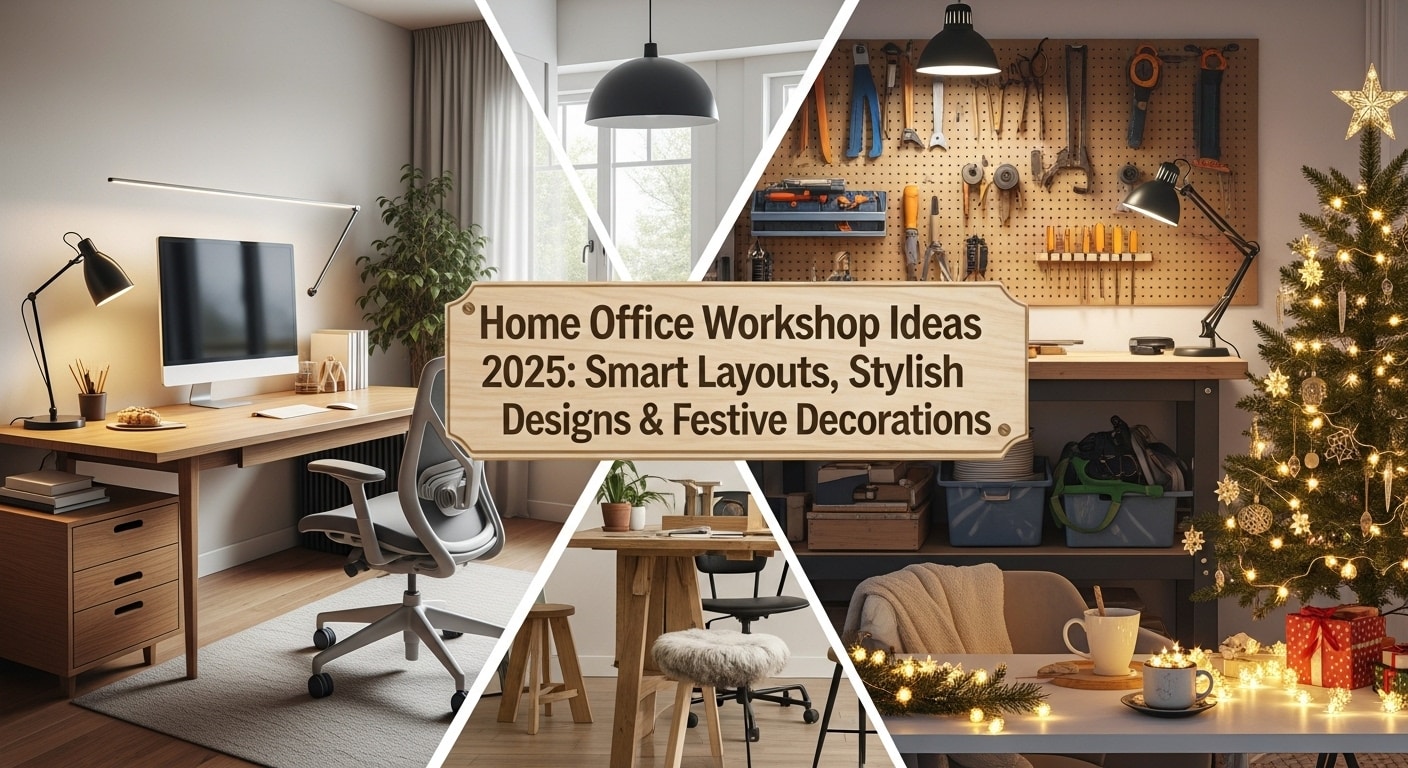The pandemic-driven work-from-home revolution has permanently transformed our approach to home workspaces. As we approach 2025, the hybrid work model has become the norm rather than the exception, pushing homeowners to create more sophisticated, multi-functional home office workshops. These aren’t just places to answer emails anymore—they’re creative hubs where productivity meets personality.
Gone are the days of makeshift desks in bedroom corners. Today’s home office workshops blend functionality with style, incorporating cutting-edge tech alongside thoughtful design elements. Let’s explore 15 innovative ideas that’ll transform your workspace in 2025.
1. The Digital-Analog Hybrid Workspace

The pendulum has swung back from all-digital setups. People are craving tactile experiences alongside their high-tech tools.
The most forward-thinking workspaces of 2025 balance digital interfaces with analog tools. Think smart desks with built-in charging stations and connectivity hubs positioned next to beautiful handcrafted organizers. Cork boards and paper planners sit comfortably beside transparent OLED screens that can switch from opaque work mode to transparent when you need to connect with your surroundings.
This ain’t just about nostalgia—it’s about cognitive flexibility. Research shows that physical writing improves memory retention and creative thinking, while digital tools excel at organization and accessibility.
2. Compact Car Garage Workspace
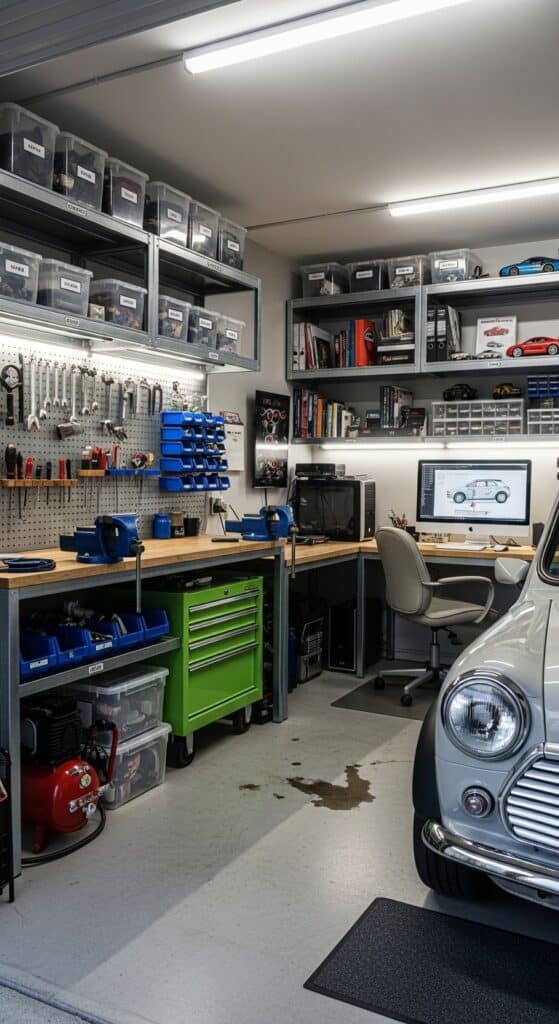
The untapped potential of garage spaces has finally entered the mainstream. Converting a portion of your garage into a workshop offers separation from home life without the commute.
Modern garage workshops utilize smart zoning—parking space remains intact while a workshop occupies one well-defined section. Climate control is essential here; mini-split HVAC systems provide targeted heating and cooling without renovating your entire garage. Weatherproofing techniques have advanced significantly, with specialized insulation panels that temporarily attach to garage doors during work hours.
What makes these spaces special is there adaptability. Modular workbenches on locking casters can be repositioned when you need to park your car, while ceiling-mounted storage systems keep tools accessible but out of the way. Some homeowners are installing glass partitions that showcase classic cars as inspiration pieces for there creative work—automotive art meets functional workspace.
3. Biophilic Design Integration

Nature-inspired workspaces aren’t just beautiful—they’re scientifically proven to reduce stress and enhance creativity.
The 2025 approach goes beyond a desk plant, incorporating living walls that double as air purifiers. Hydroponic garden stations provide fresh herbs and vegetables right beside your desk, while circadian lighting systems mimic natural daylight patterns to support your body’s rhythms. Some workshops feature small water features that create both visual interest and soothing white noise.
Sustainable materials dominate these spaces—reclaimed wood desks, bamboo organizers, and cork acoustic panels create a warm atmosphere while minimizing environmental impact. These elements aren’t just decorative; they’re functional components of a healthier work environment.
4. Multi-Function Furniture Revolution

Space efficiency defines 2025’s most innovative home office furniture designs.
Convertible pieces transform with minimal effort—desks that become drafting tables, storage ottomans that unfold into guest seating, and wall systems that conceal office equipment when not in use. Smart furniture with built-in charging capabilities and hidden tech compartments eliminate cable clutter. Height-adjustable everything is the norm, with desks, shelving, and seating that adapts to different users and tasks.
The coolest development is furniture that learns your preferences. AI-enhanced chairs automatically adjust to your posture throughout the day, while smart desks recognize when you’ve been sitting too long and gently prompt movement breaks.
5. Acoustic Management Solutions

Sound control has emerged as a critical concern for home workers dealing with family noise, neighborhood disturbances, and video call clarity.
Modular acoustic panels now double as decorative elements, available in customizable patterns, colors, and even with integrated LED lighting. Directional microphones and adaptive sound dampening technologies create “sound bubbles” around workspaces. White noise generation systems have evolved into personalized soundscapes that enhance focus without causing fatigue.
The most impressive innovation is transparent acoustic barriers—clear panels that block sound without blocking light or creating visual separation. These can be deployed as needed and stored compactly when not in use, making them perfect for homes where space is at a premium.
6. Smart Storage Systems

The clutter-free workspace isn’t just an aesthetic choice—it’s linked to improved cognitive function and reduced stress.
2025’s storage solutions use vertical space more effectively with modular wall systems that adapt as your needs change. Color-coded organizational systems employ both visual cues and RFID tagging to help locate items quickly. Robotic storage assistants—small automated units that retrieve supplies from hard-to-reach places—are becoming more affordable for home use.
The game-changer is predictive organization. Smart storage systems track which supplies you use most frequently during different projects and reorganize themselves accordingly, ensuring what you need is always within reach.
7. Immersive Virtual Meeting Zones
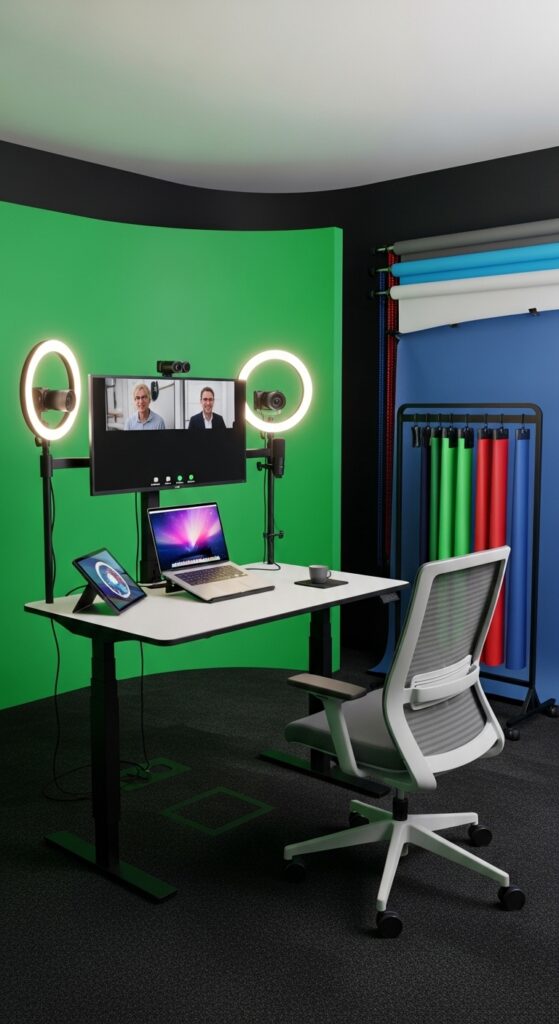
As remote collaboration continues to evolve, dedicated spaces for virtual interaction have become essential.
The latest virtual meeting zones feature curved green screen backdrops that require minimal space but create professional-looking environments. Lighting systems automatically adjust based on time of day and meeting platform to ensure you look your best. Directional audio capture technology isolates your voice while filtering out household noises.
Some enthusiasts are creating mini-studio setups with multiple camera angles and touch-screen presentation boards that digitize handwritten notes in real time. These spaces often include quick-change backdrops and props for different types of meetings, transforming from professional conference room to creative brainstorming environment in seconds.
8. Wellness-Centric Workshop Design

Health considerations now drive workspace planning, with ergonomics just the starting point.
Air quality monitoring and purification systems have become standard features, often integrated with smart home hubs. Movement-encouraging layouts intentionally separate frequently used items to promote regular stretching. Meditation corners provide space for mental breaks, featuring comfortable seating, sound isolation, and calming visual elements.
What’s really innovative is the integration of fitness equipment that doubles as office furniture—balance board floors, resistance band attachments for desks, and subtle workout equipment disguised as decor. These elements make movement breaks convenient without sacrificing professional appearances during video calls.
9. Festive Seasonal Adaptation Systems

Personalizing your workspace for holidays and seasons improves morale when working from home.
Modular decoration systems use magnetic components and standardized attachment points to quickly transform spaces without damaging surfaces. Programmable LED lighting allows instant atmosphere changes with preset seasonal themes. Smart glass panels can switch from transparent to displaying digital decorations or mood-enhancing scenes.
The most clever approach is the “decoration zone” concept—dedicating specific areas of your workspace to seasonal decor while maintaining professionalism elsewhere. This creates a personal touch thats visible to you but can be easily moved out of camera frame for meetings.
10. Space-Saving Layout Optimization
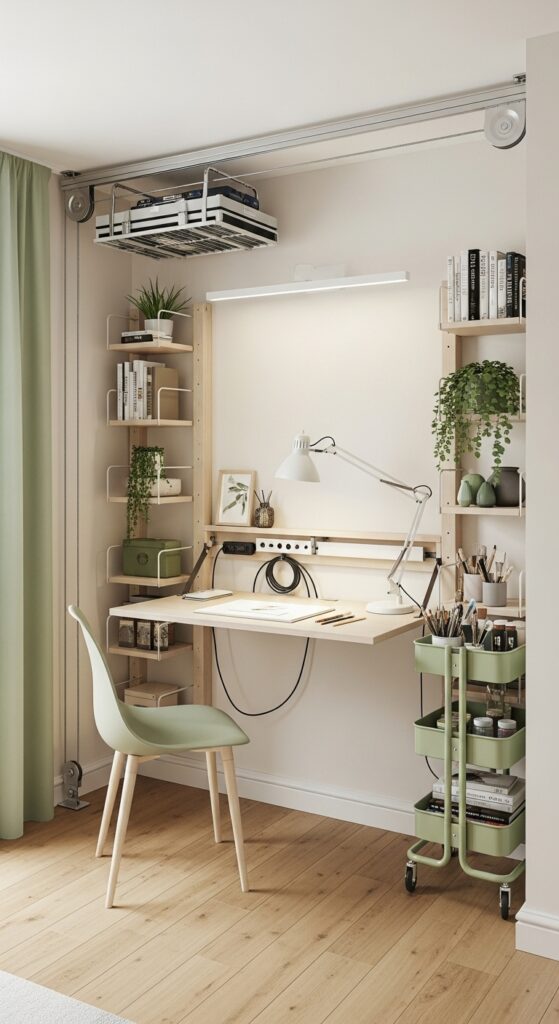
Square footage remains precious, pushing designers to maximize every inch of workshop space.
Corner-utilizing furniture designs make use of traditionally awkward spaces with L-shaped and triangular configurations. Ceiling-mounted systems have evolved beyond simple hooks to include pulley systems for equipment storage and dropdown work surfaces. Wall-mounted fold-down desks now include integrated cable management and charging systems that remain functional in both open and closed positions.
The innovative approach is the “workshop in a box”—entirely self-contained workspace units that can be wheeled into closets or spare corners when not in use, complete with task lighting, power supply, and essential tools.
11. Creative Industry-Specific Adaptations

Generic workspaces are giving way to specialized environments tailored to specific creative pursuits.
Digital artists are incorporating drawing tablet arms that swivel over regular desks, along with specialized lighting to reduce screen glare. Crafters are installing modular workbench systems with interchangeable tops for different activities—heat-resistant surfaces for soldering, self-healing mats for cutting, and cushioned areas for detail work. Writers are creating distraction-free zones with acoustic dampening and limited connectivity.
The most exciting development is the rise of convertible spaces that transform based on project type, with task-specific equipment that nests together when not in use, allowing one space to serve multiple creative disciplines.
12. Micro-Workshop Pods

For homes without dedicated office space, self-contained workshop pods provide privacy and focus.
These compact units range from phone booth-sized spaces for calls to larger structures that accommodate a full desk setup. Ventilation and climate control systems operate independently from the main home. Sound isolation technology has improved dramatically, with thinner materials achieving better results.
What makes these truly special is their mobility—many new designs can be disassembled and reassembled in a weekend, allowing them to move with you from home to home. Some innovative versions can even be used outdoors during good weather, creating flexible indoor-outdoor workflow options.
13. Heritage-Meets-High-Tech Aesthetics

The sterile, minimalist look is fading as workers seek spaces with more character and warmth.
Vintage furniture pieces are being upcycled with modern technology—antique desks retrofitted with wireless charging and hidden USB ports. Traditional craftsmanship techniques are being applied to tech accessories, like hand-carved wooden laptop stands and leather cable organizers. Historical design elements like library ladders, card catalogs, and drafting tables are making comebacks in modern interpretations.
The most interesting trend is the “hidden tech” approach, where cutting-edge equipment is housed in classic designs—modern computers in vintage radio cabinets or smart home hubs disguised as antique books. This creates spaces that feel timeless rather then trendy.
14. Workshop Lighting Revolution

Lighting technology has transformed dramatically, with options that enhance both productivity and ambiance.
Task-specific lighting with adjustable color temperatures helps transition between different types of work. Circadian systems automatically shift throughout the day to support natural energy cycles. Ambient lighting options create gentle indirect illumination that reduces eye strain and headaches.
The breakthrough is adaptive lighting that responds to your behavior—brightening when you’re reading physical documents, dimming slightly during screen work, and gradually shifting to signal the end of your workday. These systems learn your preferences over time, creating personalized lighting environments.
15. Multi-Sensory Experience Design
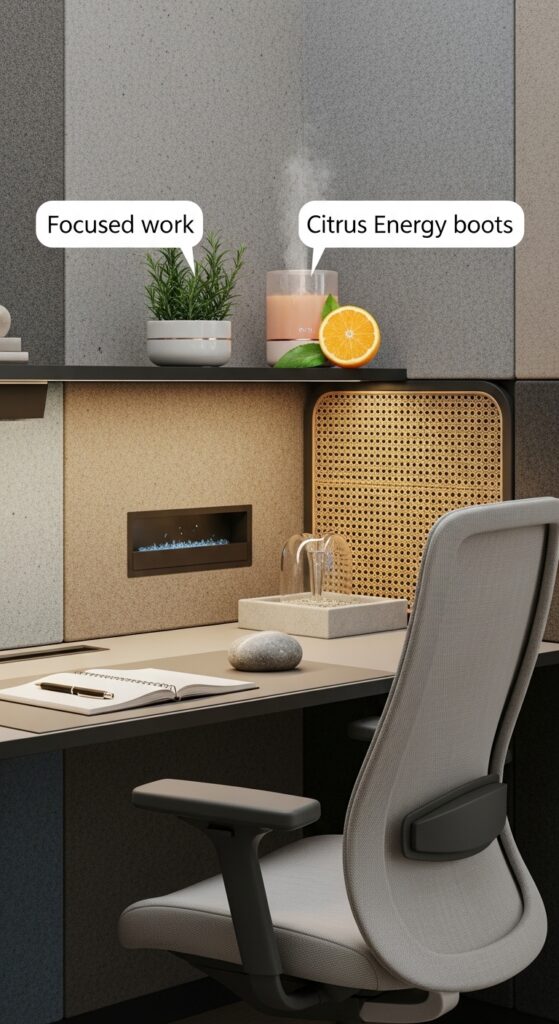
The most forward-thinking workspaces engage all senses to create environments that enhance focus and creativity.
Scent diffusion systems release productivity-enhancing aromas like rosemary for focus or citrus for energy. Textural diversity incorporates materials that provide tactile stimulation—smooth stone surfaces for cooling overworked hands, textured wall panels for momentary sensory breaks. Acoustic elements include both sound-dampening features and optional background soundscapes tailored to different tasks.
What’s truly revolutionary is the personalization of these elements—systems that learn which sensory combinations help you focus best during different types of work and automatically adjust your environment accordingly.
Making It Work in 2025 and Beyond
Creating your ideal home office workshop isn’t about implementing every trend simultaneously. It’s about identifying which elements support your specific work style and space constraints.
Start by analyzing your daily workflow—which tasks consume most of your time? What physical and digital tools do you use regularly? Where do current inefficiencies occur? This assessment forms the foundation for thoughtful design decisions.
Consider not just what you need today but how your work might evolve over the next several years. Flexibility is key; modular systems allow your space to adapt as technologies and work requirements change.
The most successful home office workshops reflect there owners’ personalities while supporting practical requirements. They balance aesthetics with function, combining beauty with purpose. In 2025, the distinction between home and office continues to blur, but that doesn’t mean sacrificing either comfort or productivity.
Whether you’re converting a garage corner, maximizing a spare bedroom, or carving out space in a living area, these fifteen ideas provide a roadmap for creating a workspace that’s not just where you work, but where you thrive. The perfect home office workshop isn’t about perfection—it’s about creating an environment that supports your unique creative process and professional needs.

Mariana is the founder and voice behind Home Nookery, a curated blog dedicated to home design, décor inspiration, and cozy living. With a passion for creating beautiful, functional spaces, Mariana shares practical tips, styling ideas, and thoughtful insights to help readers turn their houses into homes. Whether you’re redesigning a room or just adding a touch of charm, she’s here to guide you with creativity and heart.
